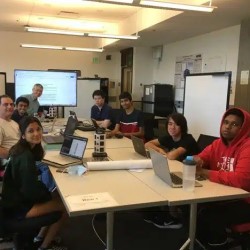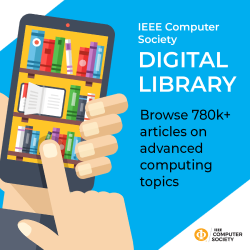Best Practices for Conferences
IEEE Computer Society encourages all our conference organizers to promote and facilitate greater diversity and inclusion in their activities.
The IEEE Computer Society is committed to Diversity and Inclusion (D&I) across all its sponsored activities, including conferences.
These are some ideas to promote and increase D&I in your conferences and communities. Most are best practices already implemented at conferences sponsored by IEEE and other organizations. Does your conference already do some of these D&I activities? Is there a super cool activity that we have not thought of? Did you try one of these activities? How did it turn out? Send an email to inclusion@computer.org with (1) a short description of the activity and (2) a link to a description of the event from the conference website that hopefully includes pictures! We will make sure to add your conference as an example on the list below.
Conference Organization
D&I Chair
Conferences are starting to embrace the role of D&I Chair as an essential part of the organizing committee. The role of a D&I Chair, according to Jo Atlee from the software engineering community:
“The role of a D&I Chair is to help ensure that all aspects of the conference are equitable, diverse, inclusive, and accessible. A lot of the work is about being observant (ensuring that communications are D&I), proactive (about diversity among invited speakers), firm (with respect to code of conduct), and creative (with respect to onsite initiatives).
It is important to start early, so that you can have an impact on communications, invited speakers, website design, etc.”
Program Committee Self-Nomination
It is very important to renew and reinvigorate program committees over time. Create a form for people to self-nominate as members of the program committee. For early career committee members consider a mentoring or shadowing program to provide advice and ensure review quality.
IEEE Computer Society Committee to assist in Reporting Ethics and Conduct Violations (CS Assist)
CS Assist is a volunteer-led program that acts as a resource to assist members of the conference community with referring misconduct concerns including harassment, discrimination, bullying, and other ethical policy violations to the IEEE Ethics Reporting Line or other authorities, as necessary. Organizers are encouraged to include a CS Assist committee at their conferences. More information on CS Assist can be found here.
Small Group Activities
The goal of these activities is to create spaces for underrepresented communities or affinity groups to meet in person to discuss plans for increasing representation, create collaborations, find support, or simply mingle with other people. These activities should be included as a part of the formal program so that people are aware of them and conference resources as assigned to ensure their success.
This is a very simple activity that is very easy to organize; for example:
- Breakfast, lunch, or meetup for an underrepresented group within your community
- Annual LGQBT+, Women’s or BIPOC breakfast or luncheon
- Meetup for local attendees
There are many groups that exist but rarely get a chance to meet in person. These activities provide an opportunity for these groups to make stronger connections and plan activities for the future; for example:
- Face-to-face annual meeting of members of a mailing list
- Workshops or symposiums for underrepresented communities, organized by underrepresented communities
It is so much easier to connect when there is a topic of theme in common and you are in your affinity group. These activities help to connect within those groups in a much more relaxed environment; for example:
- Dedicated 24/7 networking spaces
- Workshop or symposium associated to or sponsored by an established organization as WIE
Many research collaborations and long-term friendships start at conferences. Provide spaces for people to connect. For example, many conferences have student lounges or rooms with tables to host small meetings.
- Networking programs
It is difficult to become part of a community, especially when you are a minority. A program such as a mentor-protégé program is targeted at creating networking opportunities for underrepresented groups.
- Ad Hoc Meetups
Provide opportunities for underrepresented groups to meet each other. For example, invite affinity groups to gather at the end of the day to go out to dinner as a group. Consider having sign up sheets or notes at tables indicating where to meet.
- Meeting for discussion of D&I topics
Schedule meetings for discussion of D&I topics such as D&I support in academia or industry, introducing D&I topics in the classroom, mental health awareness, work-life balance, etc.
- D&I Book Club
Select a book related to D&I and invite conference attendees to read the book in advance and come together to discuss.
Plenary Conference Events
These are plenary events that the full conference participates in. They are targeted at showing their commitment to D&I and discussing D&I issues as a community.
- Panel on a topic related to D&I
Panels are great ways to create discussions around topics related to D&I. Organize a panel around current events, experiences, activities for increasing participation, community challenges, etc.
- Keynotes and Special Invited Talks by Underrepresented Community Members
Keynote speakers are the superstars of your conference. Commit to diversity in keynote speakers to introduce role models for everyone in your community.
Support for Underrepresented Groups to Attend the Conference
Sometimes it is difficult for underrepresented groups to attend conferences due to family commitments, financial issues, disabilities, or simply lack of time. These activities can make it easier for these people to attend.
- Child care
Child care at conferences would enable people with small children to attend. Consider offering child care at the conference venue for free or at a reduced cost.
- Financial support for companions of attendees with disabilities
Traveling is very difficult for people with disabilities and becomes very expensive if they need to travel with a companion.
- Reduced registration rates for one-day passes for Industry
People in industry want to learn about the latest research but may not have five days to attend a conference.
- Reduced registration rates for local attendees when conferences go to underrepresented countries
Conference registrations are becoming very expensive, which when added to travel costs, make it very difficult for people in many countries to attend. When conferences visit these countries, make an effort to provide them with the experience. Consider having reduced rates for local attendees, perhaps offset by local corporate donations.
LGBTQ+ Inclusivity
The LGBTQ+ community is representative of a spectrum of intersectional identities, expressions, and communities. The following suggestions will guide your conference efforts to create a more affirming environment for professionals and students. In order to create solutions that are applicable to all, we must give space for others to show up authentically and contribute their own experiences.
- Include pronoun identification as part of the event registration process.
- Show pronouns on name badges, or offer stickers at the registration desk.
- Ensure communications from the conference and conference representatives are mindful of pronouns (using they/them).
- Ask for pronoun identification during the registration process
- Be mindful of gender identity and try to avoid referring to gender as sex-based. If you document gender through your registration site, be sure to include inclusive options. Suggested “Gender Identity” options:
- Male (some may prefer to identify as Man)
- Female (Some may prefer to identify as Woman)
- Prefer to self describe as _________ (non-binary, gender-fluid, agender, please specify)
- Prefer not to answer
- Choose a conference location in an LGBTQ+ friendly location.
- Be aware of city and state policies, including laws that could be discriminatory, and select locations accordingly.
- Get perspective from the LGBTQ+ community.
- Find out how any of the work your organization does might be affecting the community and ask what you can do better.
- Establish a Diversity, Equity, and Inclusion Chair for your conference:
- Provide a budget for them to run programs that exemplify, highlight, or foster DEI events and LGBTQ+ participants within the conference.
- LGBTQ+ Lunch and Learn for the community
- Bringing in members of the LGBTQ+ community to learn about specifics of the conference.
- Lunch and Learn
- Bringing in members of the LGBTQ+ community to talk about their community and their experiences to attendees who wish to learn.
- Link to local resources for the LGBTQ+ community in the area.
- LGBTQ+ Lunch and Learn for the community
- Provide a budget for them to run programs that exemplify, highlight, or foster DEI events and LGBTQ+ participants within the conference.
- On-stage representation
- Ensure a diverse and inclusive slate of speakers
- Bring in guest speakers that represent the LGBTQ+ community
- Use LGBTQ+ or LGBTQ+ friendly vendors.
- Research vendors and consider asking Convention and Visitors Bureaus (CVBs) if they know of any or have recommendations.
- D&I starts at the top:
- Have a diverse and inclusive steering committee.
- Ensure that the Conference Organizing Committee, Program Committee etc. are diverse.
- Community outreach
- Conference representatives speak to LGBTQ+ groups, highlighting computer science and engineering opportunities, career paths, etc.
- Allow members within the local LGBTQ+ community to set up an informational booth, highlighting local support services.
- Engage College LGBTQ+ Communities
- Reach out to local college and high school campus LGBTQ+ resource centers to identify and recruit student volunteers.
- Build a comfortable and respectful space for all conference volunteers and attendees, honoring their wishes when it comes to gender identity, sexual orientation, etc.
- Ask individuals how you can be respectful.
- Remind organizers that tone and body language are important.
- Highlight contributions of LGBTQ+ individuals to the conference’s field of interest.
Safety Considerations for Conference Locations
Keeping the intersectionality and diversity of your attendees in mind is an important consideration when selecting the site of your conference. While it is not always feasible to select a conference location that is guaranteed to align with all diversity, equity, and inclusion goals, it is important to support those who are historically excluded from the technology ecosystem. These recommendations will assist you with the site selection process.
Choose a conference location that is inclusive and welcoming to your attendees and community.
- Be aware of city and state policies, including laws that could be discriminatory, and select locations accordingly.
- The conference location should align with the principles outlined in the IEEE Code of Ethics.
Many resources exist that provide insight into the safety of various countries and territories for various groups. A sampling of resources is listed below:
- Most Dangerous and Safest Countries Index
- Countries and Territories Global Freedom Scores
- The 50 Worst (& Safest) Countries for Solo Female Travel
- The 203 Worst (& Safest) Countries for LGBTQ+ Travel in 2022
Consider partnering with an organization that provides an opportunity to balance your purchases in a location that doesn’t align with your personal values by making a donation to a non-profit that “offsets” the money you are spending.
- SocialOffset helps individuals offset spending that does not align with their core values, by making it easy to donate to local charities and organizations that do.
Adding a virtual component to your conference expands accessibility for those who are not able to participate in person. Learn more about IEEE Computer Society hybrid event options.
Travel Grants
Travel grants can help to offset some of the costs for underrepresented groups to attend the conference. Consider offering targeted travel grants, such as
- Travel Grants for Students from Underrepresented Countries
- Travel Grants for Students from Underrepresented Groups
- Travel Grants for Early Career Faculty
Awards
Many conferences and communities have awards for best paper, best reviewer, best project, and others. Consider awards targeted at underrepresented communities or use your awards to promote D&I.
- Awards specifically for underrepresented communities
Consider having awards for the underrepresented communities in your conference
- Name awards after influential members of the community that come from underrepresented groups
Show your support for D&I by naming awards after underrepresented members of the community
- Award for Service in improving D&I
Reward those members of your community that have contributed to D&I in your community
First-Time Attendees
Attending a conference for the first time can be nerve-wracking, especially for students. Create events or special activities so that they can meet other people.
- First-time attendee reception
Many conferences have first-time or newcomer receptions, with activities to get new people involved. The goal is for new attendees to have people to sit with at the conference, network, or simply go out to dinner. One idea from our meeting planners is to have high tables and no chairs at the reception and for each table to have a sign that gathers people on what they want to do next such as “Want to have Chinese after we are done?” or “Want to go to workshop X tomorrow?”
- First-time mentors
Offer to pair first-time attendees with someone that is known in the community. Mentors are assigned in advance based on areas of interest expressed by newcomers during registration.
- New industry attendee welcome event
For many of our conferences, industry attendees are a minority. A welcome event where industry attendees can get together and receive advice on how to make the most out of attending the conference is a good idea to welcome them to the community. Members of the Steering Committee and Organizing Committee should attend and engage in conversations about industry needs and interests, and perhaps invite them to take on bigger roles within the community.
For best practices about engaging industry visit https://www.computer.org/conferences/organize-a-conference/organizer-resources/engaging-industry
- Special first-time attendee tables at conference dinners
This would encourage people that do not know anybody to attend the conference dinner and meet new people.
- Special badges for first-time attendees
This would encourage other first-time attendees to interact. In addition, mentors in the community and organizing committee members should go out of their way to talk to them and introduce them to others.
- Special badges for trained mentors/hosts
First-time attendees may not want to self-identify by wearing badges or may not want to make an initial move for networking because of lack of confidence or experience. Trained hosts/mentors with visible badges that reflect the amount of mentorship, affinity groups, and research area, for example, have the job of looking out for first-time attendees and open to answering questions and making connections.
Accessibility
There are many actions that a conference can take to ensure accessibility for all attendees
- Include accessibility evaluation of the conference venue as part of the criteria for location. Items to evaluate include wheelchair accessibility to conference rooms, elevators, accommodations for food sensitivities, ease of transportation from airports and nearby hotels to the conference venue, etc.
- With virtual and hybrid conferences, ensure that your virtual platform supports closed captioning and review the quality of the output. Similarly, having the option to increase the size of the speaker window is very important for attendees that are hearing impaired.
- Ensure that the conference website meets accessibility guidelines such as W3C’s WCAG 2.0.
- The conference web site should include all accessibility information such that attendees can make informed decisions about whether they can attend.
Other Ideas
This is a list of simple activities and ideas to promote D&I at your conference.
- Diversity recognition
Make badges, ribbons, or pins that show that you belong to an affinity group or minority. For example, LGBTQ+, heritage (e.g. Hispanic), pronouns, languages spoken (e.g.”Yo Hablo Español”, “Parlo Italiano”)
- Code of Conduct and D&I Statement on a poster at the registration desk
Make both of these fully visible as people register for the conference so that there is a clear understanding of how people are expected to behave at the conference.
- Reporting diversity numbers for conferences
Conferences should report this information on their web sites: gender, nationality, pronouns, industry/academia/government, etc.
- Local college student invitations
Invite college students who may be interested in the field of your conference field to attend a morning or afternoon of talks. Organize a special talk for the students and faculty on a hot topic in the field, industry experience, or the graduate student experience. Have senior members of the community come and meet them during the break.






